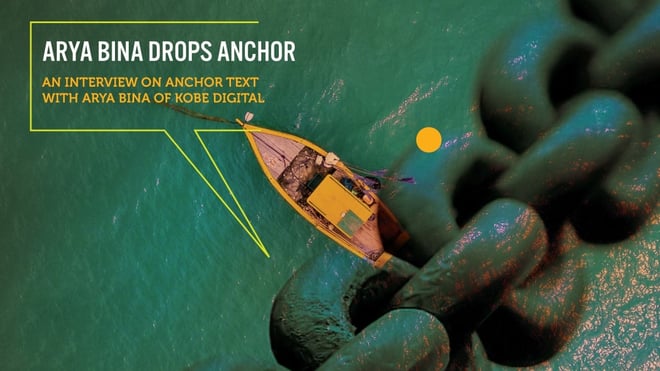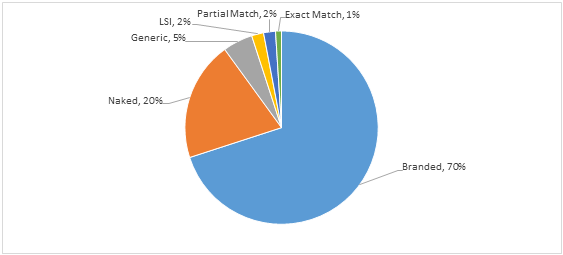It’s always nice to have the chance to have a conversation with the talented people within our industry.
Previously, I talked with Dan Petrovic from Dejan SEO. Today I have the opportunity to share an interview with Arya Bina, founder of Kobe Digital.
I sat down with Arya to discuss the best ways to use anchor text for SEO this year.

Anchor Text in 2017
Can you quickly review what anchor text is for our readers who are new to SEO?
Sure thing—anchor text refers to the clickable text users see displayed by hyperlinks.
It’s what they physically click on when navigating links on the page. On the search engine side, anchor text serves as an indicator of what the linked content is about.

As a result, carefully chosen anchor text is one of the many tools used by SEOs as a way to improve a given site’s ranking for specific keywords.
How has the use of anchor text changed as SEO techniques have evolved?
In the past, SEO was dominated by “exact match” anchor text—that is, if you wanted to rank for the keyword “buy widgets online,” you’d use “buy widgets online” ver batim as the anchor text for every single backlink you built to your site.
While this proved effective in improving search rankings, it was a technique often exploited by low-quality, spammy sites using low-quality, spammy links.
This all changed when Google rolled out its Penguin update in 2012 as a way to penalize sites attempting to manipulate rankings through anchor text.
Now, over-optimized link profiles—typically those that are too keyword-dense and are comprised of several exact match anchor text links—are hit with a penalty, allowing websites with more “natural-looking” anchor text profiles to rank higher instead.
Given these changes, what does the ideal anchor text profile look like in 2017?
As I mentioned earlier, sites with the most “natural-looking” anchor text profiles will do the best.
Practically speaking, this means ensuring that a very, very small proportion of your backlinks have exact match anchors text—think something in the 1% range. The majority of your backlinks should have “branded” anchor text: that is, anchor text that displays your company or organization name. Check out this article from Smart Insights to learn how branded text can also affect your SEO ranking.
The majority of your other backlinks should have “naked” anchor text, in which the anchor text is simply the URL for the hyperlink destination. The remainder is best assigned to generic anchor text (think of a “click here” or “download now” type of link) and LSI or partial match anchor text.
LSI stands for “Latent Semantic Index” and is similar to a partial match in that it is simply a variation of the target keyword (the difference is in how it’s sourced: LSI variations are found in the “related searches” section of the SERP, while partial match variations are ones you’ll need to create yourself).
Most experts typically agree on a split that looks something like this:

Again, these percentages are broad guidelines, not exact targets that you need to aim for—the goal, after all, is to resemble a natural anchor text profile.
Managing Anchor Text Profiles
In your opinion, what’s the most underused anchor text technique?
It’s pretty easy to rack up branded, naked, and generic anchor text backlinks—these will come naturally as you build relationships, create and distribute content, and organically expand your link profile.
Meanwhile, as I mentioned earlier, too many exact match anchor text links can actually be counterproductive to improving SERP rankings. That leaves LSI and partial match anchor text as good candidates for anchor text types that deserve more attention.
One way of implementing this is page title anchor text (anchor text that matches its respective page title). Adam White has written a piece about this over at Search Engine Journal, reporting a correlation between page title anchor text and first position SERP rankings. At the moment, this is something our team is taking a closer look at, but from what we know so far it appears that it can be effective and is currently underused.
That’s a lot to keep track of—how can SEOs and webmasters monitor their anchor text profiles?
We may no longer be living in the golden age of SEO—that was probably sometime in the late 1990s and early 2000s when PageRank was king and manipulating the algorithm was much simpler—but we’re certainly living in the golden age of SEO analytics.
Now more than ever, SEOs and webmasters have countless choices of analytics tools to use for crawling websites, measuring ranking factors, and monitoring SERP positions.
When it comes to keeping an eye on anchor text profiles specifically, our team prefers to use Open Site Explorer. OSE aggregates all of the different anchors associated with each of the pages linking back to a website in an easily readable format that makes it a breeze to get an idea of what the anchor text profile looks like at any given time.
Majestic and Ahrefs are also popular with SEOs and webmasters for checking anchor text profiles. SEMRush has the same capability as well. Regularly monitoring the outputs of tools such as these—especially if you’ve been building links aggressively—is a great way to prevent simple mistakes that could lead to penalties from Google, like having too many exact match anchors.
What’s the biggest misconception you have encountered when it comes to anchor text?
I think that with all of the reporting and analytics capabilities available today, many SEOs suffer from information overload and become caught up in the details.
They’ll start to focus on achieving what they believe to be an “optimal” anchor text profile while losing sight of the big picture—curating great content that users will want to consume and share—and the quality of their backlinks will begin to suffer as a result. It’s a classic case of not being able to see the forest through all of the trees.

Google has been very clear in the past that the best way to think about SEO is to approach your website with your end user in mind first; search engines should be a distant second. If you’ve acquired a branded anchor link for the sole purpose of bringing that category’s weight in your anchor profile to exactly 70%, but at the expense of content quality, then you’ve missed the point entirely.
Google’s ranking algorithm has finally grown sophisticated enough to effectively distinguish between quality and quantity, and now ranks results accordingly.
Don’t ever compromise the quality or integrity of your content for the sake of chasing after some arbitrary SEO metric that someone told you was a silver bullet for rankings—it’s simply never worth it.
What’s something you see SEOs and webmasters overlook when managing anchor text?
As I mentioned before, when anchor text profiles aren’t monitored on a regular basis—a mistake that there’s simply no excuse for given how many easily accessible software options there are for this these days—the number of exact match anchors can really creep up on you. Then, before you know it, your site might be showing something like 10% - 15% exact match anchors and be at high risk for penalization.
From our experience, e-commerce sites with large affiliate programs are especially vulnerable to these types of situations. With publishers trying to embed affiliate links within their content as naturally as possible, crucial anchor types such as naked anchors and branded anchors tend to be used less often, if at all.
While many publishers will use generic anchors such as “Click here” or “Buy now,” some will inadvertently use exact match anchors for keywords you are attempting to rank for, increasing your risk of being penalized by Google.
Though we’ve only seen this happen a few times, the rapid adoption of affiliate programs by publishers (affiliate income was the fastest-growing revenue source for publishers last year) leads us to believe that this could become a more frequent problem going forward if advertisers aren’t careful.
Many advertisers provide their affiliates with pre-written copy and pre-made creatives, which is a great way to manage this risk while also standardizing brand messaging across publishers.
Future of Anchor Text
What can SEOs and webmasters expect going forward?
Google’s goal is provide the highest quality, most relevant search results for its users.
Any updates made to its ranking algorithm typically do a good job of bringing them closer to this goal. The only advice that has withstood the test of time is stated plainly in the company’s webmaster guidelines: design for users, not search engines.
While keeping up to date on newly released quantitative studies helps us SEOs incrementally improve things like anchor text optimization, one thing that remains certain is that you’ll never get hit with a penalty for finding out what content adds the most value for your users and delivering it.
That's a Wrap!
And that concludes our interview. Big thanks to Arya for taking the time to answer my questions!
What was your favorite part of this interview? Do let us know in the comments section!

